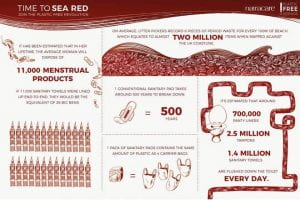For those unaware Planned Parenthood has a fairly straightfoward explanation to the question “what is menstruation?” Simply put menstruation (a.k.a a period), is a natural usually monthly processes in which blood and tissues from a woman’s uterus comes out of her vagina. Prior to the European conquest of indigenous people, feminist historians and scholars like Fred E.H. Schroeder argue that while indigenous cultures marked menstruation with rituals, western societies on the other hand have simply ignored it covering the whole affair in silence.
Thus, in a 1978 satire published in Ms. magazine, feminist Gloria Steinem attributes the lack of normalcy surrounding a woman’s period to the fact that men are not the ones magically menstruating. Steinem’s essay states if men where the ones having periods, “menstruation would become an enviable, boast-worthy, masculine event.” As a result, Steinem envisioned a world in which menstruation would ultimately justify a men’s place anywhere. As well as, leading to the creation of products with dazzling names like “Paul Newman Tampons” and “Muhammad Ali’s Rope-a-Dope Pads.”
Unfortunately, forty years after the publication of Steinem’s essay it still holds the same relevance seeing as there has been close to no improvements made towards menstrual equality. For instance, while the 1970s was the first time in which a rise in Toxic Shock Syndrome was seen. The Washington Post has recently reported on five cases of menstrual-related toxic shock syndrome (TSS) in the state of Michigan nearly fifty years later. TSS is a complication that arises from an infection with certain types of bacteria in which the body has a dangerous response to the toxins they produce that could lead to death. The Centers for Disease Control and Prevention (CDC) describes TSS as showcasing symptoms such as high fever, a sunburn-like rash, low blood pressure, etc. Sadly, women who have their period are most likely to get TSS due to the chemicals used when making these menstrual products such as tampons and pads.
Not only are these products bad for their targeted audience, it is also harmful to the environment. Estimates show that the average woman will dispose of 11,000 sanitary products throughout years of menstruation. A report posted by the National Geographic found that in the year 2018 alone, people in the U.S. bought 5.8 billion tampons the majority of which end up in landfills as plastic waste. One pack of sanitary pads contains the same amount of plastic as 4 bags one tends to carry their groceries in. As a result, menstruation can be characterized as a problem for Ecofeminist.
Ecofeminism arose in the 70s and 80s combining feminist and environmental theories and activisms. Ecofeminist believe the only way to end the oppression felt by the natural world and women is to combine the two in order to examine the patriarchal power structures put in place. Within her essay Ecofeminism: Historic and International Evolution Hobgood-Oster, defines Ecofeminism as challenging structures rather than individuals. These structures consist of classism, racism, sexism, heterosexism, naturism, and speciesism. Ecofeminism also addresses oppressive systems and their manifestation of abusive powers by reinforcing assumptions of categorical hierarchies, such as heaven/earth, male/female, white/non-white, human/animal. Therefore they believe all forms of opposition must be dismantled otherwise humanity will remain divided.
Ecofeminist scholar Karen J. Warren describes eight connections between women and nature. Out of those eight I found the first connection to be the most interesting. The alleged connection of woman and nature through history truly interested me after reading the novel The Red Tent which is classified as a historical fiction. The novel is loosely based on the Biblical story of Dinah, daughter of Jacob and Leah. While she is a minor character in the Bible, the author Anita Diamant broadens not only Dinah’s story but also the other female characters typically glanced over in the Bible. The book’s title refers to the tent in which women of Jacob’s tribe must take refuge while menstruating or giving birth. Within the tent the women are not only empowered but also find mutual support and encouragement from their mothers, sisters and aunts. They are able to practice old rituals no longer accepted by Jacob and his God. Rather the Women teach Dinah to worship their Goddess and give thanks for her menstruation seeing as it is a sign of her femininity and intern nature as her blood signifies fruitfulness and nourishment to Mother Earth.
Sources
https://static.independent.co.uk/s3fs-public/thumbnails/image/2018/07/01/10/nc-infographic.jpg?w660
https://www.independent.co.uk/life-style/health-and-families/the-silence-around-menstruation-a7000051.html

